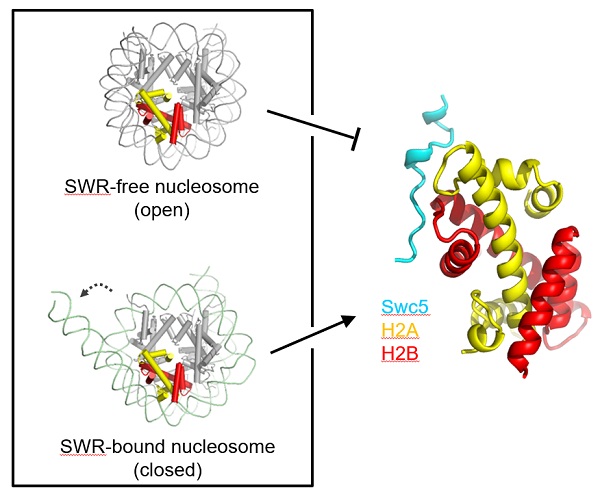
Eukaryotic DNA is packaged into chromatin by wrapping over histone octamer (including two copies of histone H2A, H2B, H3, and H4). Eukaryotic cells mobilize histones at specific locations along the chromosome to regulate genomic processes.
Histone variant H2A.Z decorates nucleosome at most promoters in yeast and mammalian cells. H2A.Z in corporation alters chromatin structure to modulate transcriptional responses. H2A.Z-H2B dimer deposition is catalyzed by chromatin remodeling complex SWR, a process accompanying with the removal of nucleosomal H2A-H2B dimer.
SWR subunit Swc5, which is essential for the exchange process, has been implicated in H2A-H2B dimer removal. However, how Swc5 liberates the nucleosomal H2A-H2B to orchestrate nuclesome editing remains unclear. In a study published in PNAS, Dr. ZHOU Zheng’s group from the Institute of Biophysics (IBP) of the Chinese Academy of Sciences and Dr. Ed Luk’s group from Stony Brook University revealed the molecular mechanism of Swc5 in regulating SWR-catalyzed histone exchange.
In this study, the researchers determined a 2.37-A crystal structure of Swc5 in complex with H2A-H2B, providing the structural basis for how Swc5 contributes to the directionality of the H2A-to-H2A.Z nucleosome editing process. The structure shows that Swc5 engages H2A-H2B using a tandem DEF/Y motif within its intrinsically disordered region, generating a unique “tridentate mode,” which includes a core electronic interaction network and flanking hydrophobic interactions.
With the recombination of isothermal titration calorimetry (ITC) assay and in vitro histone exchange experiment, the researchers showed that DEF/Y motif of Swc5 is required for H2A-H2B binding and optimal SWR function, whose mutation inhibits the nucleosome editing function of SWR in vitro.
Moreover, in vivo crosslinking analysis showed that Swc5 DEF/Y interacts with histone in yeast cell, and the extent of this interaction is dependent on the remodeling ATPase of SWR, supporting a model in which Swc5 acts as a wedge between the nucleosomal DNA and H2A-H2B to promote H2A-H2B dimer eviction.
Altogether, these findings lay the molecular basis of Swc5 in recognition of H2A-H2B and provide critical insight into how Swc5 facilitates SWR-catalyzed nucleosome editing.
The staff of the BL-19U1 beamlines at the Shanghai Synchrotron Radiation Facility and the IBP have provided technical support to this work.

Swc5 recognizes H2A-H2B dimer (right panel) to facilliates SWR-catalyzed H2A removal (left panel) (Image by Dr. ZHOU Zheng’s lab)

86-10-68597521 (day)
86-10-68597289 (night)

52 Sanlihe Rd., Xicheng District,
Beijing, China (100864)

